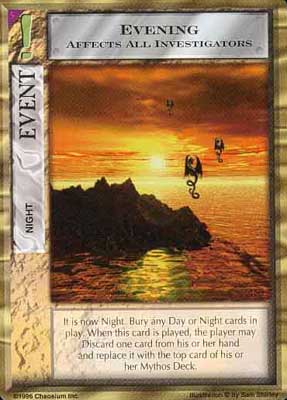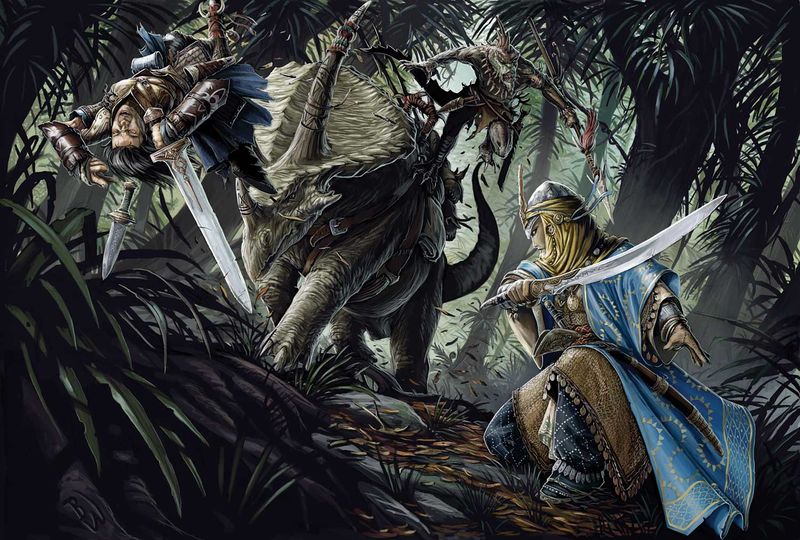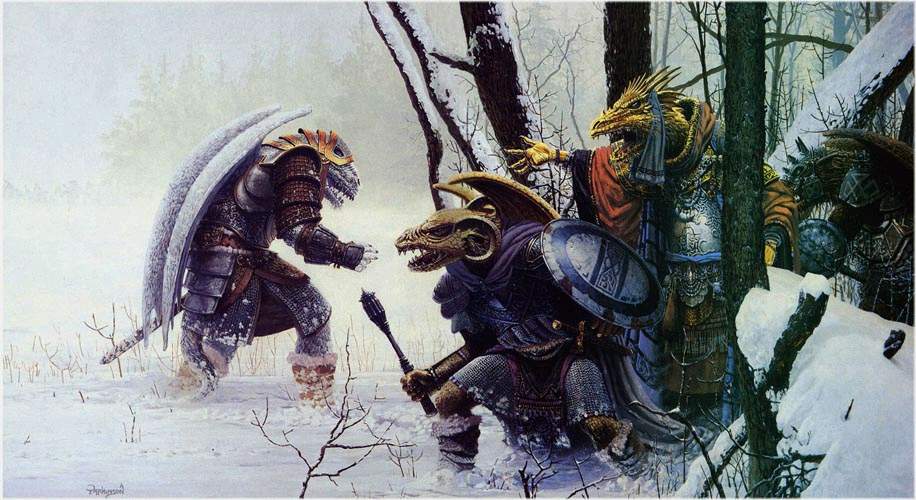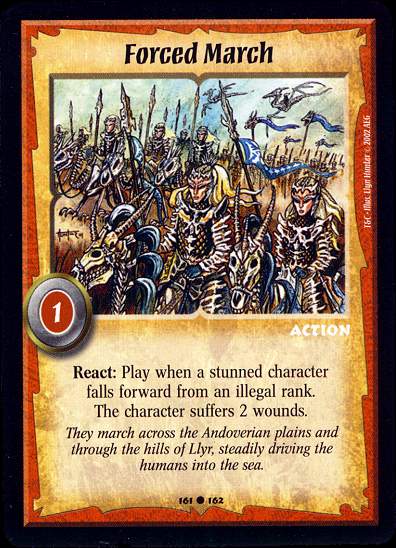

|
|
|
|
|
|
|
|
|
|
|
|
|
|
|
|
|
|
<>
Starting
from the point of origin, your players will move over not only
varying types of terrain
but through areas of varying human and demi-human
population as well. Just
as terrain will affect the frequency
and type of
monsters encountered, so
will population dictate likelihood and type of
encounter. You must, therefore,
show population density on your large
scale map -- or at least
have some idea of it in mind as adventurers move
across the land. The chance
of encounter is set with the following bases:
| Population Density | Base Chance of Encounter |
| relatively dense <DMG.C: Inhabited And/Or Patrolled> | 1 in 20 |
| moderate to sparse/patrolled <DMG.C: Inhabited And/Or Patrolled> | 1 in 12 |
| uninhabited/wilderness | 1 in 10 |
FREQUENCY OF ENCOUNTER CHANCE TIME CHECKS: Check for Encounter At
| Type of Terrain | Morning
(8-12)
<d4: 8, 9, 10, 11> |
Noon
(12-4)
<d4: 12, 1, 2, 3> |
Evening
(4-8)
<d4: 4, 5, 6, 7> |
Night
(8-12)
<d4: 8, 9, 10, 11> |
Midnight
(12-4)
<d4: 12, 1, 2, 3> |
Pre-Dawn
(4-8)
<d4: 4, 5, 6, 7> |
| Plain | x | - | x | - | x | - |
| Scrub | x | - | x | x | - | x |
| Forest | x | x | x | x | x | x |
| Desert | x | - | - | x | - | x |
| Hills | - | x | - | x | - | x |
| Mountains | x | - | - | x | - | - |
| Marsh | x | x | x | x | x | x |
x = check for encounter
- = do not check unless
party numbers over 100 creatures
<added times>
<WATERBORNE ENCOUNTERS
Fresh Water
Encounter occurs 1 in 20,
check morning, evening, and midnight.
Salt Water
Encounter occurs 1 in 20,
check dawn and noon in coastal and shallow waters, check only once during
daylight (usually noon) in deep water.>
<Underwater Encounters>

Daylight hours consist of
morning, noon, and evening;
night consists of night,
midnight, and pre-dawn.
These times equateof about
an hour after the party sets forth for the day,
the mid-point of the journey,
and near the end when camp
is being made with respect to daylight hours.
During hours of darkness,
equate the periods to first,
middle,
and end sleep periods.
Where only 1 or 2 chances
for encounter exist,
you may vary the time as
you see fit in order to avoid player reliance on information which they
should not be privy to.
When an encounter check
isindicated,
roll
the appropriate die,
and if
a 1 results,
an encounter
takes place.
In this event,
go to the appropriate table for the terrain,
<FF, DMG>
and determine randomly what sort of monster is being encountered.
Note: In areas where
you have detailed the monster population,
a random determination should
not be necessary,
as this information should
be recorded by you.
When an actual meeting does
occur,
consult the explanations
accompanying the table for any special procedures to follow.
Attempts by the encountering
party to evade are dealt with under COMBAT,
PURSUIT AND EVASION OF PURSUIT (q.v.).

Outdoor
adventures are mainly treks to reach some destinarion or exploration
expeditions.
Never mention hexes or squares,
of course.
Just say that the party
has traveled what seems like X miles.
Terrain description is the
way to channel the team--roads, tracks, game trails, gullies, canyons,
passes, wharever.
"There is thick brush to
the north and a cliff to the south, so continuing westwards seems the most
likely route through this area."
Of course you should have
a map where there are set encounters that can be used to keep the session
interesting.
Of course, regular random
encounter checks in wilderness--three in daylight, three in darkness also
liven things up...even if no encounter occurs or the result is a weather
change.
As the GM be prepared to
invent a lot in such adventures ![]()
Cheers,
Gary

If either party is surprised,
the encounter distance is
determined by subtracting the value of surprise
(as determined by the die
which indicated that the condition existed) from normal encounter distance.
Normal encounter distance
is 6" to 24" (6d4).
Thus, on a surprise roll
of 1, for example, encounter distance is 5" to 23" (6d4 -1),
on a 2 the distance is 4"
to 22", etc.
In addition to shortening
encounter distance,
surprise also allows the
surprising party to have that number of segments as shown on the die as
the surprise factor as free and unanswered activity to move, attack, flee,
etc.
(See SURPRISE.)
In addition to modification
for surprise, terrain will also modify
encounter distance as follows:
| Scrub -- | -1 per die on all 3's and 4's |
| Forest -- | -1 per die on all numbers (00's are possible) |
| Marsh -- | -1 per die on all 2ís 3's, and 4's |
Plain, desert, hills, and
mountains
do not
alter encounter distance variables unless one of the three modifying types
of terrain also exists.
If final encounter distance
is 1" or less,
then
a confrontation will usually take place.
Confrontation:
Confrontation indicates that the adventurers and some monster have met
at close proximity,
and some interaction is
likely to take place. There are, however, modifying circumstances:
1) If the monsters are intelligent
and would normally deem themselves to be weaker than the party of adventurers,
then they will always seek
to avoid such confrontation.
2) If the party of adventurers
surprises the monsters and elects to flee the encounter,
they may attempt to avoid
confrontation by using free segments of action to move out of confrontation
distance and evade the monsters.
Confrontation interaction
can consist of any number of actions, singly or
in combination ~ parley
and reaction, spell casting, missile fire, melee
combat, etc.
Movement:
As mentioned previously,
movement rates hove been given elsewhere.
There rates assume that
a party of from 1 to 100 creatures are concerned.
If more than 100 are in
the party,
reduce movement rate by
1 mile per day for each additional 100 or fraction thereof,
but in no event should such
adjustment slow the rate of movement of the party to below 50% of normal
speed.

Any party not guided by a
creature knowledgeable of the countryside through which the party is moving,
or which is not following
a well defined course (river, road, or the like),
or which is not using a
well-drawn and correct map,
might become lost.
-
This is determined prior
to the commencement of a day's movement.
Determination is based on
the terrain:
| Terrain Type | Chance Of Becoming Lost | Direction |
| Plain | 1 in 10 | 60° left or right |
| Scrub | 3 in 10 | 60° left or right |
| Forest | 7 in 10 | any |
| Rough | 3 in 10 | 60° left or right |
| Desert | 4 in 10 | 60° left or right |
| Hills | 2 in 10 | 60° left or right |
| Mountains | 5 in 10 | 120° left or right |
| Marsh | 6 in 10 | any |
To find the direction of
movement if a party is lost, roll d6, 1-3 indicating left,
4-6 indicating right.
Each hex face is 60°.
If a loss of direction of
120°
is possible,
roll
a second d6,
1-3 indicating a 60° direction loss,
4-6 indicating 120°.
In any direction,
loss is possible,
roll
a single d6,
with results being read off clockwise considering the intended direction
of travel as 12 o'clock,
and giving 2 chances for complete loss and movement in the exact opposite
direction, thus:
1 = right ahead, 2 = right behind, 3-4 = directly behind, 5 = left behind,
and 6 = left ahead,
i.e. there is NO chance
of the party ever accidentally moving in the desired direction
when
the die indicates the condition
of being lost exists.
Direction of lost movement
is illustrated below:

Procedure For Lost
Parties:
As soon as the die roll
indicates the party is lost,
determine the direction.
If it is onto a space which
has previously been travelled over and mapped by the party,
then they will recognize
that they became lost.
Tell them that they moved
in X direction,
rather than that which was
desired,
but they have seen landmarks
and realize their error.
If movement is into on orea
where the party has not already been and mapped,
then immediately roll again
to determine if the party will be lost the next day also.
If no such lost direction
is indicated,
then the party will realize
it has made an error the next day;
but meanwhile describe terrain
as if they had actually moved in the desired direction,
i.e. as if they had not
been lost with regards to direction.
This will,
of course,
result in the erroneous
mapping of a space until corrected.
If the party will also be
lost the following day,
the procedure above is followed
until they are no longer lost.
At that point,
they will realize thot they
have not been moving in the desired direction,
or series of directions,
but they will NOT know just
where they became lost.
They will have to back-track
and attempt to locate the last space which they mapped correctly and go
on again from that place.
It must be understood that
parties following a correct map will never be come lost.
Procedures are only for
explorotion of unmapped terrain.
REST:
Movement rates are postulated on sufficient daily rest periods so as
to obviate the necessity
for ony protracted REST periods of a day or more
during the course of any
journey. If normal movement rate is exceeded,
however, then special rest
periods in addition to any subsumed brief
breaks in travel ore required.
This is detailed below:

It is possible to make forced
marches up to twice the distance shown
for daily movement rate.
Such forced movement increases
the daily rate in 10% increments, from 10% to 100% at the option of the
party,
to a maximum of double normal
movement rate; but as soon as a total of 100% of additional normal movement
rate is reached,
or as soon as the party
determines to assume non-forced movement, whichever first occurs, a mandatory
rest period must be enforced. Rest period depends upon the total percentage
of forced movement:
10% - 30% = 1 hour per 10%
40% - 60% = 2 hours per
10%
70% - 100% = 3 hours per
10%
To find the time required
for enforced rest,
simply find the total percentage
of rest time and deduct this from normal daily movement rate.
Thus, 30% means that 30%
of movement the next day is deducted,
as the party rested during
that period.
At 3 hours per 10% increment
of forced movement, 70% equals 210%, so 2 full days,
plus 10% of a third day
must be spent in rest from the forced march.
Failure to rest after normal
movement is equal to 100% means that beasts of burden have a cumulative
chance of dropping dead of 10% per 10% increment of additional movement
of any sort.
Other creatures lose 1 level
of ability or hit die in the same manner,
until 0 is reached and exhaustion
kills them.
Such loss of vitality, whether
by beast of burden, creature, or character requires a full 8 hours of additional
rest for each
such 10% increment, hit
die, or level of ability lost.
For example, a 12th level
fighter who moves an additional 90% of movement after exceeding normal
movement by 100% must rest 72 hours, consecutively, in order to regain
12th level of ability. Prior to that period of rest, the character is effectively
3rd level!
<how's my math?>
E=exhaustion
F=fatigue
H=hustle
M=move
P=percentage
R=rest
[Day1f: Forced Movement.
M+H.
H=(F)(P).
F=(1
to 10) P=(0.10).]
[Day2f: Rest? = go to Day2fr.
Move? = go to Day2fm]
[Day2fr] 'On the Road Again' (Remainder of the Day)
| F | 'morning' Rest' * | ORA : Mv6 | ORA : Mv9 | ORA : Mv12 | ORA : Mv18 | ORA : Mv24 |
| 1 | 1 hour | 10.8 | ||||
| 2 | 2 hours | 9.6 | ||||
| 3 | 3 hours | 8.4 | ||||
| 4 | 8 hours | 2.4 | ||||
| 5 | 10 hours | 0 [Day 3fr = 12] | ||||
| 6 | 12 hours | 0 [Day 3fr = 9.6] | ||||
| 7 | 21 hours | 0 [Day 3fr = 0] [Day 4fr = 10.8] | ||||
| 8 | 24 hours | 0 [Day 3fr = 0] [Day 4fr = 7.2] | ||||
| 9 | 27 hours | 0 [Day 3fr = 0] [Day 4fr = 3.6] | ||||
| 10 | 30 hours | 0 [Day 3fr = 0] [Day 4fr = 0] [Day 5 = 12] |
* Doesn't have to be morning. Just called that to ease comprehension.
[Day2fm]
F
= 'exhaustion points'
if you H,
you get F
get rid of Fwith
R
beasts of burden : Fx10
= % chance of dropping dead (check at begin ('1') of move). As soon as
you check, your F becomes E.
characters : F
= negative levels. As soon as you move (begin at ('1' of move)), your F
becomes E.
To get rid of E : Fx8 hours.
<think about the colors>
<
Adapted from Land Adventures, page 49
| Scrub -- | -1 per die on all 3's and 4's | D = 6d4(-1 if 3 or 4) -S |
| Forest -- | -1 per die on all numbers (00's are possible) | D = 6d4 -6 -S |
| Marsh -- | -1 per die on all 2ís 3's, and 4's | D = 6d4(-1 if 2 or 3 or 4) -S |
Distance = 6d4 -Surprise
D = 6d4 -S
>